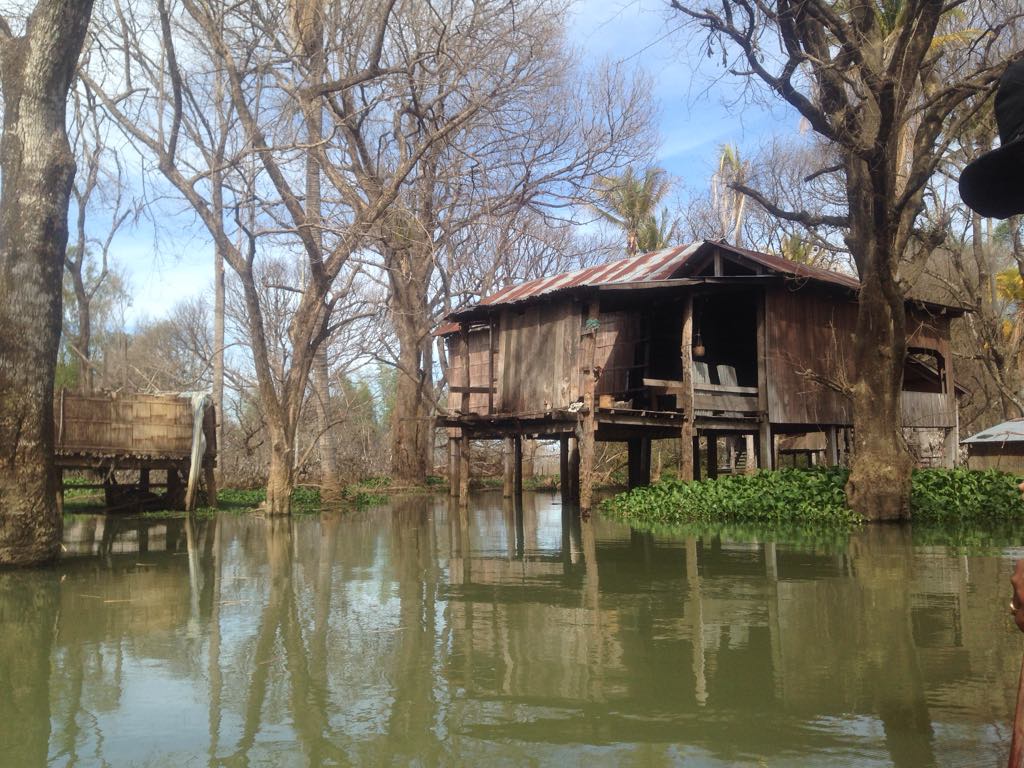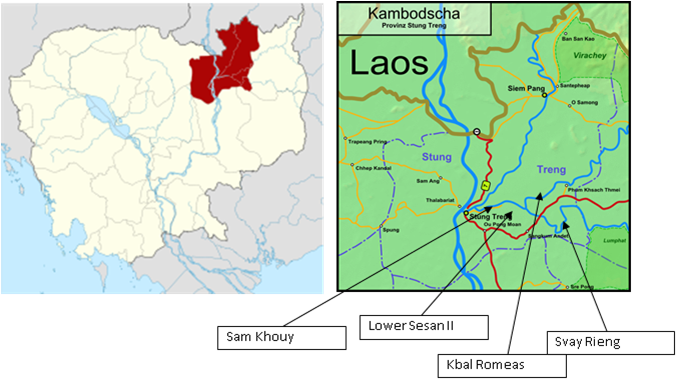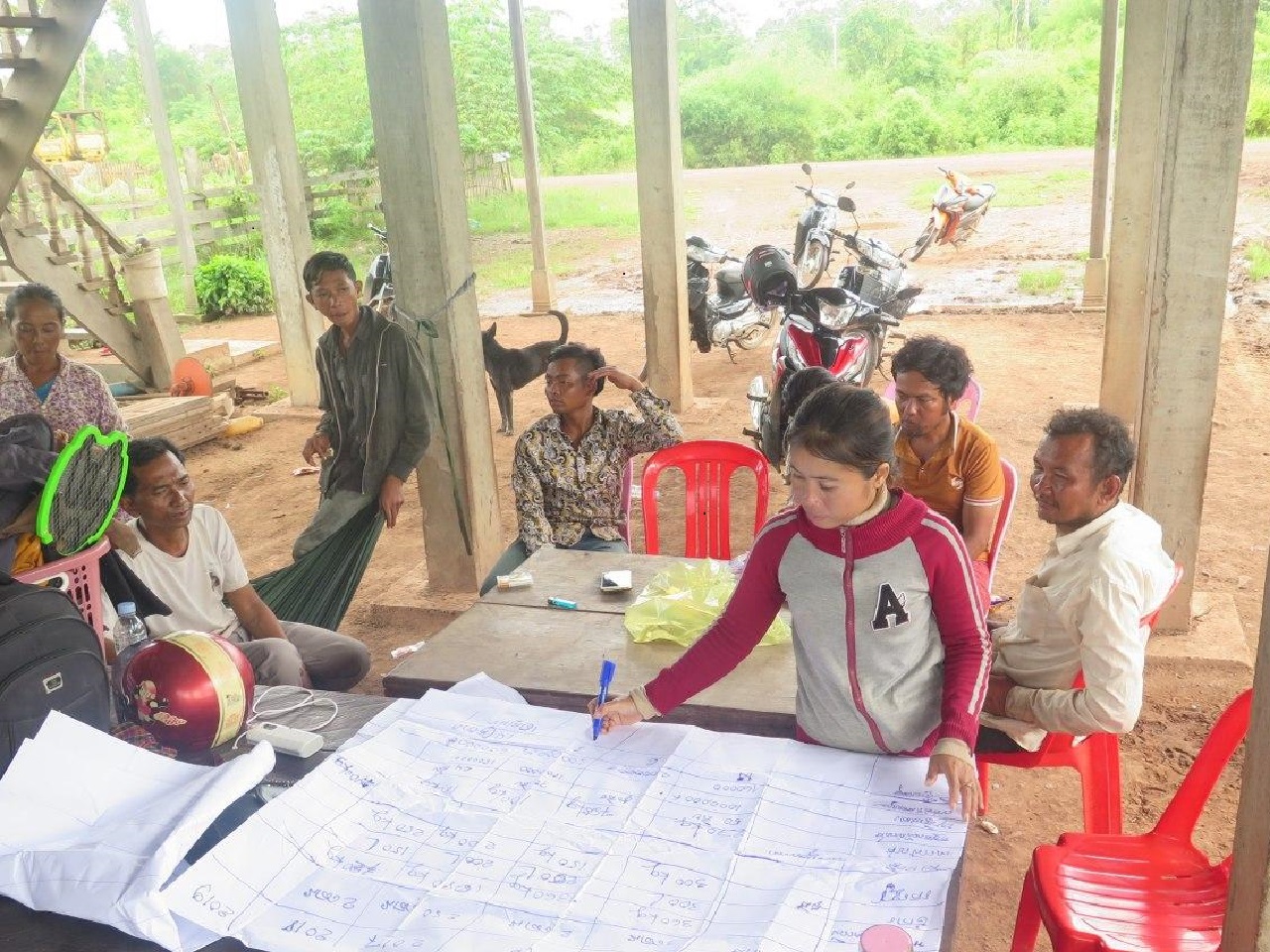Local Knowledge: Monitoring on Impacts of LS2 Hydropower Dam.
 |
LS2 Community Action Research Team | |
 |
Narith POR | |
 |
http://www.mvicambodia.org | |
 |
US$4500 |
Research Background Final Report (abstract) Others

House flooding of IP community in Kbal Romeas by LS2 dam.

Map1:The affected area by LS2 construction.
Research Background
Lower Sesan II Hydropower dam located near the confluence of the Sesan and Srepok rivers in Stung Treng province, Cambodia, the Lower Sesan 2 Dam threatens the vitality and biodiversity of two of the Mekong River's most significant tributaries.
The project was approved by Cambodia's Cabinet in November 2012 with 400MW capacities, $816 million project to be implemented by Hydropower Lower Sesan 2 Co., Ltd. is a joint venture between Cambodia's Royal Group and Hydrolancang International Energy Co., Ltd (90%) and EVN International Joint Stock Company, a subsidiary of the Electricity of Vietnam (EVN) (10%).
A 2012 study by the Proceedings of the National Academy of Sciences found that the Lower Sesan 2 Dam would cause a 9.3 percent drop in fish stocks basin-wide, while threatening more than fifty fish species. These impacts would be felt as far downstream as the Mekong Delta in Vietnam - the rice bowl of the country - and as far upstream as Laos and Thailand.
Experts have also warned that the Lower Sesan 2 Dam will contribute to the changing of the Mekong's hydrological flows,
as well as a reduction of sediment flows by approximately six to eight percent.
To increasing understanding for local people and communities along Sesan, Sre Pok rivers and people along Tonle Sap lake in Cambodia, negotiating with local authorities and companies in order that they have response and address the issues caused by the hydropower dam of LS2, influence on decision-makers to develop policies that are better condition for local
people from the development project and reduce the impacts of LS2 on environment.
The research is proposed in three villages: one village is situated at the resettlement site, one village is located at upstream and one village is located at the downstream of hydropower dam. The research sites are located at three communities of Sam Khouy, Kbal Romeas and Svay Rieng in three communes of Sam Khouy, Kbal Romeas and Talat commune in Sesan district,
Stung Treng province in Cambodia.
The province was located at the north-east of Cambodia (see the map 1: Stung Treng location in red color).
Participatory approach will be used in the research. Seven community committee members including three women from each of the three communities will become local researchers. Those community committee members will be encouraged to join in research tool development. Those local researchers will be trained on the research methodology and research tools.
Then seven local research will coordinate the data collection via group discussion with local community members in three villages. Those information and data will be documented in the draft version. The information will be verified with local community members in order to add and verify the information to be more accurate.
The last one, one workshop will be organized to disseminate the results of the research to stakeholders including community member representatives and local authorities. The research finding will be used to influence on the decision-makers. The research is conducted from January to December 2019.
[Sep. 2018]

Community meeting at the relocated area.
Final Report (abstract)
Lower Sesan II Hydropower dam located near the confluence of the Sesan and Srepok rivers in Stung Treng province, Cambodia, the Lower Sesan 2 Dam threatens the vitality and biodiversity of two of the Mekong River's most significant tributaries.
The project was approved by Cambodia's Cabinet in November 2012 with 400MW capacities, $816 million project to be implemented by Hydropower Lower Sesan 2 Co., Ltd. is a joint venture between Cambodia's Royal Group and Hydrolancang International Energy Co., Ltd (90%) and EVN International Joint Stock Company, a subsidiary of the Electricity of Vietnam (EVN) (10%).
A 2012 study by the Proceedings of the National Academy of Sciences found that the Lower Sesan 2 Dam would cause a 9.3 percent drop in fish stocks basin-wide, while threatening more than fifty fish species. These impacts would be felt as far downstream as the Mekong Delta in Vietnam - the rice bowl of the country - and as far upstream as Laos and Thailand. Experts have also warned that the Lower Sesan 2 Dam will contribute to the changing of the Mekong's hydrological flows, as well as a reduction of sediment flows by approximately six to eight percent.
To increasing understanding for local people and communities along Sesan, Srea Pok rivers and people along Tonle Sap lake in Cambodia, negotiating with local authorities and companies in order that they have response and address the issues caused by the hydropower dam of LS2, influence on decision-makers to develop policies that are better condition for local people from the development project and reduce the impacts of LS2 on environment.
The research is proposed in three villages: one village is situated at the resettlement site, one village is located at upstream and one village is located at the downstream of hydropower dam. The research sites are located at three communities of Sam Khouy, Kbal Romeas and Svay Rieng in three communes of Sam Khouy, Kbal Romeas and Talat commune in Sesan district, Stung Treng province in Cambodia. The province was located at the north-east of Cambodia.
Participatory approach has been used in the research. Seven community committee members including three women from each of the three communities were selected for local researchers. Those community committee members were encouraged to join in research tool development. Those local researchers were provided the training on the research methodology and research tools. Then seven local researchers have been coordinated to collect the data via group discussion with local community members including women, youths and people with disabilities in three villages. The information and data have been documented among local research group at provincial level. After drafting, the meeting to verify the information with local community members in order to add and verify the information to be more accurate were conducted in three villages of project target area. The last one, one workshop was organized to disseminate the results of the research to stakeholders including community member representatives and local authorities at provincial level by engaging with CBOs annual reflection workshop.
[Jan. 2020]
Others
